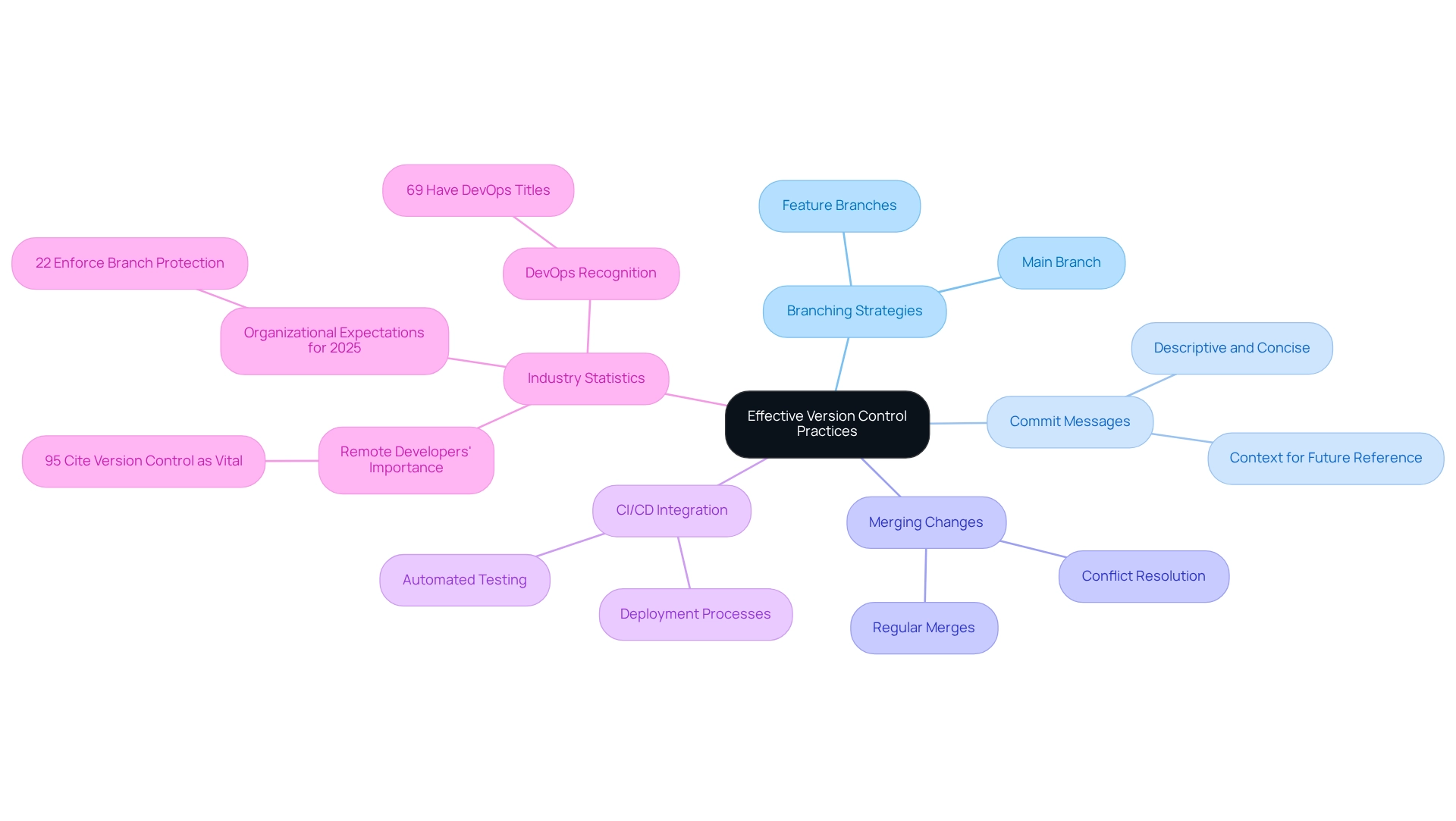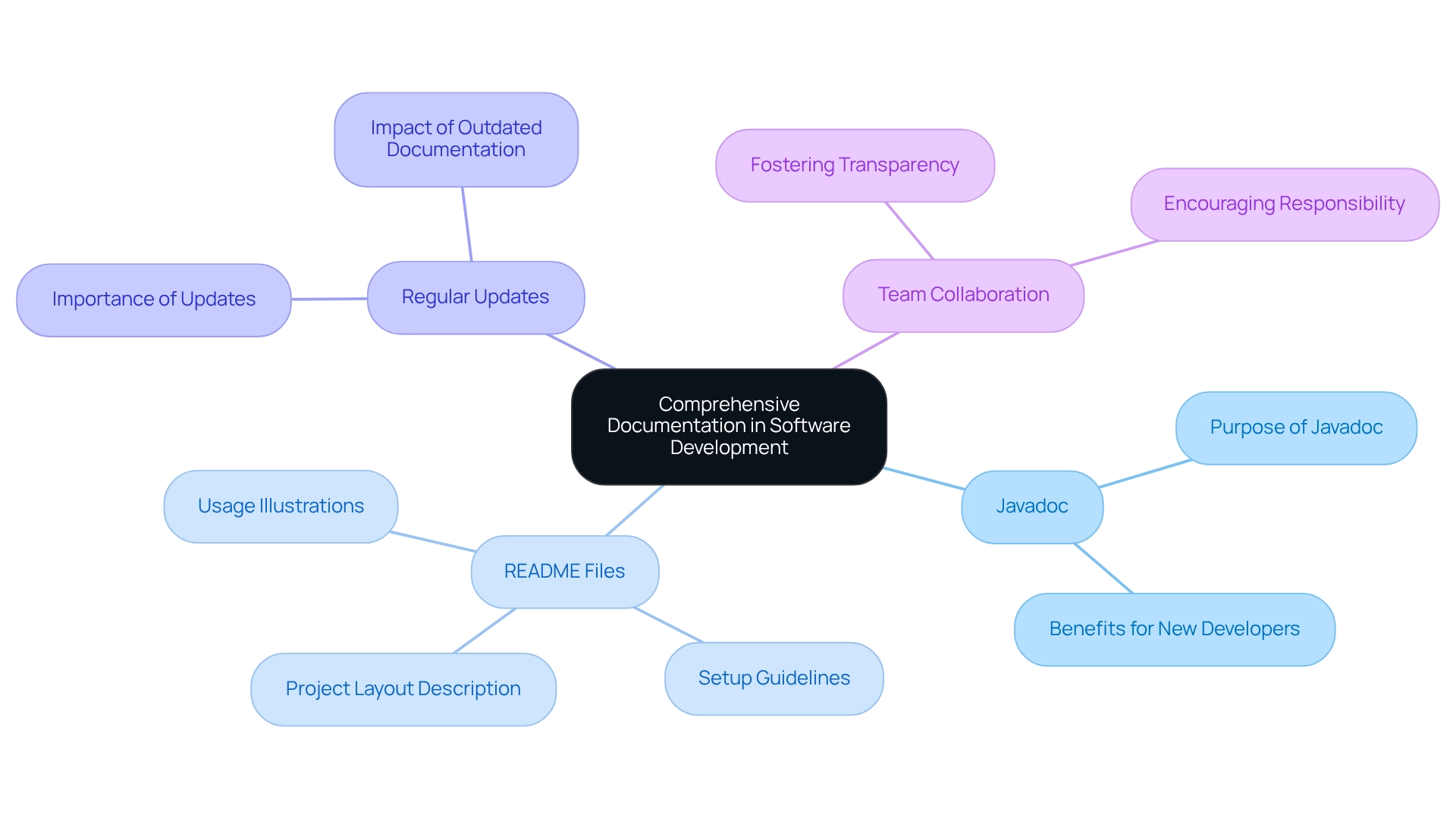Overview
Managing source code in Java can present numerous challenges for developers. However, understanding the Java ecosystem and implementing effective version control can significantly ease these difficulties. Kodezi addresses these issues by offering tools that enhance project management and facilitate collaboration through version control systems like Git. Furthermore, it ensures software reliability via automated testing frameworks and promotes clarity through comprehensive documentation.
By leveraging these features, Kodezi not only improves code quality but also boosts team productivity. Imagine a scenario where your team can collaborate seamlessly, with all changes tracked and tested automatically. Wouldn't that transform your development process?
In addition, maintaining thorough documentation becomes effortless, leading to better communication among team members. The ultimate benefit is a more efficient coding environment, where developers can focus on what they do best—writing high-quality code.
Explore the tools available on Kodezi’s platform to elevate your coding practices and experience the difference in productivity and code quality.
Introduction
In the ever-evolving realm of software development, developers often grapple with various coding challenges. How can they effectively navigate the complexities of Java's ecosystem to create robust applications? Kodezi offers solutions tailored to these challenges, featuring a myriad of libraries, frameworks, and tools designed to streamline the development process.
By leveraging Kodezi, developers can significantly enhance their productivity and maintain high code quality. Furthermore, the platform promotes effective version control strategies and automated testing frameworks, ensuring that teams collaborate efficiently. The importance of comprehensive documentation cannot be overstated, serving as a vital resource for clarity and onboarding.
Are you ready to transform your Java development journey? Explore the tools available on Kodezi and foster an environment conducive to innovation and success.
Understand Java's Ecosystem and Source Code Structure
Developers often face significant challenges in coding, from managing complex projects to ensuring code quality. Understanding the ecosystem of programming languages, which includes a variety of libraries, frameworks, and tools, is essential for overcoming these obstacles. Familiarity with this ecosystem enables developers to select the right tools for their projects effectively.
One standout solution is Kodezi, which addresses these challenges through its innovative features. For instance, a standard source code in Java structure typically includes directories for source files, resources, and configuration files. The 'src' directory should contain all source code in Java files organized into packages, while 'resources' can hold non-code files like images and configuration settings. Furthermore, utilizing tools like Maven or Gradle can help enforce this structure automatically, ensuring that all team members adhere to the same conventions.
In addition, incorporating Kodezi's CLI can further simplify this process by allowing groups to auto-heal codebases, ensuring adherence to coding standards, and boosting overall productivity. Have you ever wondered how much time you could save by automating these tasks? Kodezi's automated code debugging features empower developers to quickly identify and resolve issues in their source code in Java, optimizing both performance and security within their projects. By leveraging Kodezi, you can enhance your coding practices and improve collaboration among team members. Following a consistent framework not only fosters cooperation but also streamlines the onboarding process for new developers. Explore the tools available on Kodezi's platform and discover how they can elevate your development experience.
Implement Effective Version Control Practices
In the ever-evolving landscape of software development, effective version control is crucial for teams facing coding challenges. To address these challenges, adopting a system like Git is essential, as it facilitates branching, merging, and tracking changes. Establishing a clear branching strategy, such as utilizing feature branches for new developments and a main branch for stable releases, can streamline collaboration and enhance productivity.
Are your commit messages descriptive and concise? Providing context for future reference is vital. Regularly merging changes and promptly resolving conflicts will help maintain a clean codebase. Furthermore, combining version control with CI/CD pipelines can automate testing and deployment processes, ensuring that only stable software is released to production. This practice not only improves code quality but also increases group productivity by decreasing the time allocated for manual integrations.
Consider this: 95% of remote developers deem version control systems vital for collaborative coding, especially with the rise of remote work. With 69% of organizations having teams or individuals with 'DevOps' titles, the recognition of effective version control practices is growing in the industry. In 2025, 22% of organizations are expected to enforce branch protection to avoid force-push disasters, emphasizing the significance of these practices in contemporary software creation environments.
As Jigar Agrawal states, 'According to the latest DevOps growth statistics, companies that implement DevOps pivot faster and perform better,' highlighting the performance benefits of effective version control. Are you ready to explore how these practices can transform your development process?

Leverage Automated Testing for Continuous Quality Assurance
Developers often face significant challenges when it comes to ensuring software quality and reliability. Automated testing frameworks like JUnit and TestNG play a crucial role in addressing these challenges, enabling developers to create unit tests that run automatically with every change made. By adopting a test-driven development (TDD) approach, teams can significantly enhance software quality, as tests are designed before the actual implementation begins. Furthermore, continuous integration systems facilitate the automatic execution of these tests, providing immediate feedback on the impact of modifications.
In addition, incorporating tools for code coverage analysis is vital; these tools help identify untested areas within the codebase, guiding developers to improve their test suites. This proactive testing strategy not only boosts reliability but also cultivates a culture of quality within the team. As John Ruskin aptly stated, 'Quality is never an accident; it is always the result of high intention, sincere effort, intelligent direction and skillful execution.'
Looking ahead to 2025, the importance of automated testing frameworks in programming projects is underscored by the growing trend towards behavior-driven design (BDD). This approach emphasizes collaboration through test scenarios written in natural language, enhancing team dynamics. Additionally, the emergence of alternatives to Selenium, such as Cypress and Playwright, illustrates the shift towards user-friendly and robust testing functionalities. These advancements make automated testing an indispensable component of modern programming, particularly for maintaining the quality of source code in Java.
Are you ready to explore how Kodezi can streamline your testing processes and elevate your coding practices? Discover the tools available on the platform and unlock the full potential of your development efforts.
Maintain Comprehensive Documentation for Code Clarity
In the world of software development, keeping thorough records is essential for guaranteeing clarity in programming and promoting cooperation among development groups. Developers often face challenges related to unclear documentation and integration of new team members. How can these issues be addressed effectively? Utilizing tools like Javadoc allows developers to generate API documentation directly from the code, ensuring that each public method is accompanied by clear comments detailing its purpose, parameters, and return values. This practice not only improves comprehension but also assists in integrating new members into the team.
Furthermore, a well-organized README file is crucial; it should describe the project layout, offer setup guidelines, and contain usage illustrations. This resource can greatly facilitate the transition for new developers and act as a reference for current members. Regular updates to documentation are equally important to represent changes in the codebase. Outdated documentation can lead to confusion and mistakes, undermining the group's efficiency. By motivating group members to record their code while developing, a culture of transparency and responsibility is fostered, ultimately aiding in a more manageable codebase.
Data shows that thorough documentation is essential in software development, with the Java community on Stack Overflow alone having over 1.5 million questions labeled with Java, emphasizing the need for clear direction. Moreover, expert opinions highlight that effective documentation is not merely a formality but a cornerstone of successful software projects. By prioritizing documentation, teams can reduce technical debt and enhance the longevity of their codebases, ensuring they remain robust and adaptable as they evolve.
In conclusion, embracing thorough documentation practices can significantly improve productivity and code quality. Are you ready to explore the tools available on Kodezi to enhance your development process?

Conclusion
Navigating the complexities of Java's ecosystem presents significant challenges for developers striving to produce high-quality applications. How can teams effectively streamline their development processes? By understanding the source code structure and leveraging tools like Maven, Gradle, and Kodezi, they can ensure a consistent approach that fosters collaboration and efficiency. Furthermore, the integration of effective version control practices, such as utilizing Git and establishing clear branching strategies, enhances productivity and code quality, making it an indispensable aspect of modern software development.
Automated testing frameworks, including JUnit and TestNG, are pivotal in maintaining continuous quality assurance. By adopting a test-driven development approach and utilizing continuous integration systems, developers can catch issues early and ensure their code remains reliable. This proactive strategy, coupled with a focus on code coverage analysis, cultivates a culture of quality that is essential for successful project outcomes. In addition, how does this contribute to overall project success? It ensures that the final product meets the highest standards.
Lastly, comprehensive documentation is not merely an afterthought; it serves as a vital resource that improves code clarity and facilitates team collaboration. By prioritizing documentation, teams can mitigate confusion, reduce technical debt, and enhance the maintainability of their codebases. As the Java development landscape continues to evolve, embracing these practices will empower developers to navigate challenges effectively. Are you ready to foster an environment conducive to innovation and success?
Frequently Asked Questions
What challenges do developers face when coding?
Developers often encounter challenges such as managing complex projects and ensuring code quality.
Why is it important to understand the ecosystem of programming languages?
Understanding the ecosystem, which includes various libraries, frameworks, and tools, is essential for developers to effectively select the right tools for their projects.
What is Kodezi and how does it help developers?
Kodezi is a solution designed to address coding challenges through innovative features, including automated code debugging and tools that simplify project management.
What does a standard Java source code structure include?
A standard Java source code structure typically includes directories for source files, resources, and configuration files, with the 'src' directory containing Java files organized into packages.
How can tools like Maven or Gradle assist in managing Java projects?
Tools like Maven or Gradle can automatically enforce the standard source code structure, ensuring that all team members adhere to the same coding conventions.
What is the role of Kodezi's CLI in development?
Kodezi's CLI simplifies the coding process by allowing groups to auto-heal codebases, ensuring adherence to coding standards, and boosting overall productivity.
How does Kodezi's automated code debugging feature benefit developers?
Kodezi's automated code debugging features enable developers to quickly identify and resolve issues in their Java source code, optimizing performance and security.
What are the benefits of following a consistent coding framework?
Following a consistent framework fosters cooperation among team members and streamlines the onboarding process for new developers.




